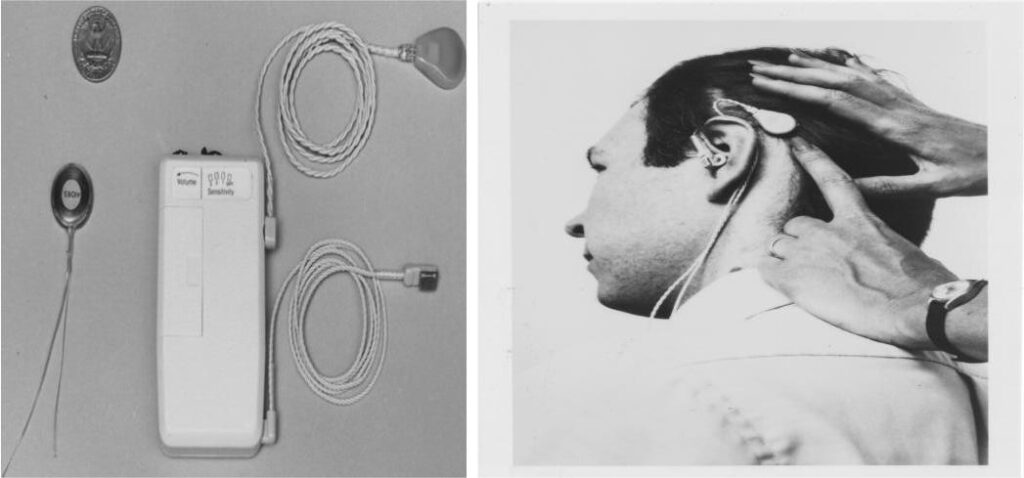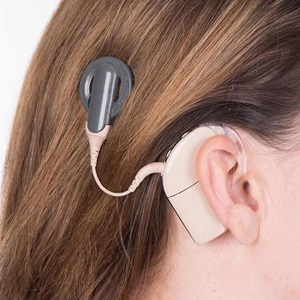History of the Cochlear Implant
In 1961, William Fouts House implanted the first cochlear implant with neurosurgeon John Doyle. Many critics were skeptical and critical of House’s work, but House’s data proved otherwise. His first patients demonstrated an ability to identify specific words and discriminate basic frequencies from one another. The image below displays one of House’s inventions, the 3M cochlear implant system, which he developed in 1973. The large block is the processor and has two wires attached to it. The top wire connects the processor to the transmitter which is placed behind the user’s ear, and the bottom wire connects to the microphone which picks up sound from the environment.

National Center for Biotechnology Information, “Figure 2”
Current cochlear implants from popular companies such as Advanced Bionics, MED-EL, and Cochlear Limited have become much more efficient than their former counterparts.
How Does the Cochlear Implant Work?
The cochlear implant (CI) captures sound signals using its transmitter and directly stimulates the auditory nerve. This process is not the same as normal hearing, so CI users will often re-learn how to understand sounds in the environment. Additionally, CIs are surgically implanted and require speech therapy for the user to adjust to this new sense of hearing. This diagram identifies different components of the cochlear implant from both external and internal viewpoints.
Rochester Institute of Technology, “Cochlear implant”
Age of Implantation
One crucial aspect of improving language growth in CI users is the age of implantation. From birth to the age of 3, children have more neuroplasticity, meaning that they are more capable of rapid learning as their brains are developing many new neural connections. If the individual experiences profound hearing loss which cannot be treated with a hearing aid, it is vital that they receive a cochlear implant before the age of 3 while their brains can more easily adapt to the cochlear implant’s electrical stimulation as a form of hearing. For individuals of older ages experiencing post-lingual deafness or hearing loss after acquiring language, there is no definitive age at which they should receive cochlear implants. It is most important that they receive CIs as early as when they first experienced either severe hearing loss or deafness. Frequent electrical stimulation from CIs aids post-lingually deafened adults in promoting new neural connections to fully develop their language and processing centers.
Cochlear Implant vs. Hearing Aid
The cochlear implant and hearing aid are often mistaken for each other, but their mechanisms work much differently. Hearing aids increase the volume of acoustic sound waves so that the user’s impaired ears can detect them. On the contrary, cochlear implants allow the user to hear using a different method. The CI receives acoustic sound from the environment and translates this into electrical signals which are brought directly to the auditory nerve instead of going through the ear itself. Typically, individuals receive hearing aids when their hearing loss is mild, while individuals receive cochlear implants when they either have severe hearing loss or are deaf. The image below presents a side-by-side comparison of the hearing aid (left) and cochlear implant (right).
(Connecthear) https://www.connecthear.org/post/all-about-cochlear-implants, “What is the difference between hearing aids and cochlear implants?”
New Developments
Hearing loss is known to more commonly affect higher rather than lower frequencies. Therefore, researchers are currently exploring methods of preserving CI users’ low-frequency hearing by placing a shortened electrode array into a part of the cochlea in order to achieve combined electro-acoustic stimulation (EAS). A systematic literature review of EAS from the University of Oxford found that the central auditory system of the brain is able to synergistically combine acoustic stimulation from residual hearing and electrical stimulation from the CI for improved pitch perception compared to standard CI users. Additionally, EAS is predicted to be especially beneficial to tonal-language speakers. For instance, standard CI users speaking Mandarin were only able to recognize an average of 57% of Mandarin tones. EAS could potentially preserve tonal information which would be very advantageous compared to conventional CIs. Despite these positive results, further studies must be conducted if combined EAS is to become the gold standard for individuals with severe high-frequency hearing loss.
Audiology Practices, “Figure 1. The Cochlear™ Nucleus® Hybrid™ L24 Cochlear Implant and Cochlear™ Nucleus® 7 sound processor with acoustic component.”
Kyle Phong, High School Research Intern
References
National Library of Medicine, “The cochlear implant: Historical aspects and future prospects”, 8 October 2012
https://www.ncbi.nlm.nih.gov/pmc/articles/PMC4921065/
JAMA Otolaryngology-Head & Neck Surgery, “The Early History of the Cochlear Implant A Retrospective”, May 2013
https://pubmed.ncbi.nlm.nih.gov/23681026/
National Institute on Deafness and Other Communication Disorders, “Cochlear Implants”, 24 March 2021
https://www.nidcd.nih.gov/health/cochlear-implants
National Library of Medicine, “The cochlear implant: Historical aspects and future prospects”, 8 October 2012
https://www.ncbi.nlm.nih.gov/pmc/articles/PMC4921065/
Rochester Institute of Technology, “Cochlear Implant”, 31 August 2011
https://www.rit.edu/spotlights/cochlear-implant
Duke Health, “Hearing Aids vs. Cochlear Implants”, 20 June 2022
https://www.dukehealth.org/blog/hearing-aids-vs-cochlear-implants
Audiology Practices, “Candidate Selection for Electric-Acoustic Stimulation Hybrid and Bimodal Cochlear Implantation”
Hindawi, “Cortical Plasticity after Cochlear Implantation”, 26 November 2013
https://www.hindawi.com/journals/np/2013/318521/
Mayo Clinic, “Cochlear Implants”, 10 May 2022
Cochlear, “How Do Cochlear Implants Work?”
National Library of Medicine, “Combined electro-acoustic stimulation: a beneficial union?”, 22 December 2008
https://www.ncbi.nlm.nih.gov/pmc/articles/PMC3381718/
Nature, “Integration of acoustic and electric hearing is better in the same ear than across ears”, 2 October 2017
https://www.nature.com/articles/s41598-017-12298-3
John Hopkins Medicine, “Cochlear Implant Surgery”
https://www.hopkinsmedicine.org/health/treatment-tests-and-therapies/cochlear-implant-surgery
